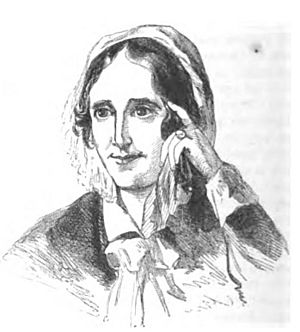Margaret Mercer facts for kids
Quick facts for kids
Margaret Mercer
|
|
|---|---|
 |
|
| Born | July 1, 1791 |
| Died | September 17, 1846 (aged 55) Belmont, Loudoun County, Virginia
|
| Nationality | American |
| Occupation | Abolitionist, educator |
Margaret Mercer (July 1, 1791 – September 17, 1846) was an American woman who worked to end slavery. She was also a dedicated educator. Margaret freed the enslaved people she inherited from her father. She even helped six of them travel to Africa. Mercer started a school and a chapel in Loudoun County that welcomed Black people. In 2018, a special marker was placed in Virginia to honor her work.
Contents
Early Life and Family
Margaret Mercer was born on July 1, 1791, in Galesville, Maryland. Her father, John Francis Mercer, was a governor and politician in Maryland. Her mother was Sophia Sprigg. Margaret was their fourth child.
She grew up at her family's home called Cedar Park. Margaret loved to read many books from her father's large library. Even though her family had enslaved people on their farms, Margaret believed slavery was wrong. She never married.
Margaret Mercer's Career
When her father died in 1821, Margaret inherited some of his 72 enslaved people. She wanted to free them and help them move to Africa. However, her father's estate had many debts. Selling the enslaved people could pay these debts, but Margaret did not want to break up families.
Teaching in Virginia
Margaret moved to Essex County, Virginia. There, she lived with her uncle, James Mercer Garnett. She taught at a nearby school called Elmwood for four years. Margaret taught classes five days a week. She also helped teach Sunday school.
On Saturdays, she worked for the Virginia Colonization Society. This group was part of the American Colonization Society. They believed in buying freedom for enslaved people. Then, they would help them settle in Africa. In 1823, the American Colonization Society bought land in West Africa. They named this new place Liberia.
Freeing Enslaved People
In 1825, Margaret returned to Maryland. She started a school for girls at her family's Cedar Park home. The money from the school helped her pay off her father's debts. After that, Margaret freed all the enslaved people she had inherited. She sent six of them to Liberia.
They traveled on a ship named Margaret Mercer. The ship's captain wrote a positive letter about his trip. This letter was published by people who supported colonization. However, three years later, three of the freed people had died. One moved back to the United States, and another moved further away.
Belmont Academy
In 1836, Margaret Mercer bought a large farm in Virginia called Belmont. She opened a new school there called "Belmont Academy." Margaret wanted to teach about farming. She believed this knowledge could show that slave labor was not needed.
Other subjects taught at Belmont Academy included:
Most of her students were daughters of wealthy families from the South. They paid $250 each year for tuition. Margaret hired seven teachers. She also built Belmont Chapel in 1841. It was a place for church services and Bible study. Children of enslaved people and freed people attended services with the schoolgirls.
Death and Legacy
Margaret Mercer died on September 17, 1846, at Belmont. She was 55 years old and had tuberculosis. She was buried on the estate.
Margaret never married. After her death, her estate was sold in 1851. The Belmont manor house was later placed on the National Register of Historic Places in 1980. Today, it is used as a place for events.
Religious services continued at the Belmont chapel until 1936. The chapel was destroyed in 1967. In 1990, a new church, St. David's Episcopal Church, was built on the same site. In 2018, a special Virginia historical marker was put up to honor Margaret Mercer. Community leaders and politicians from Loudoun County and Liberia attended the dedication.

